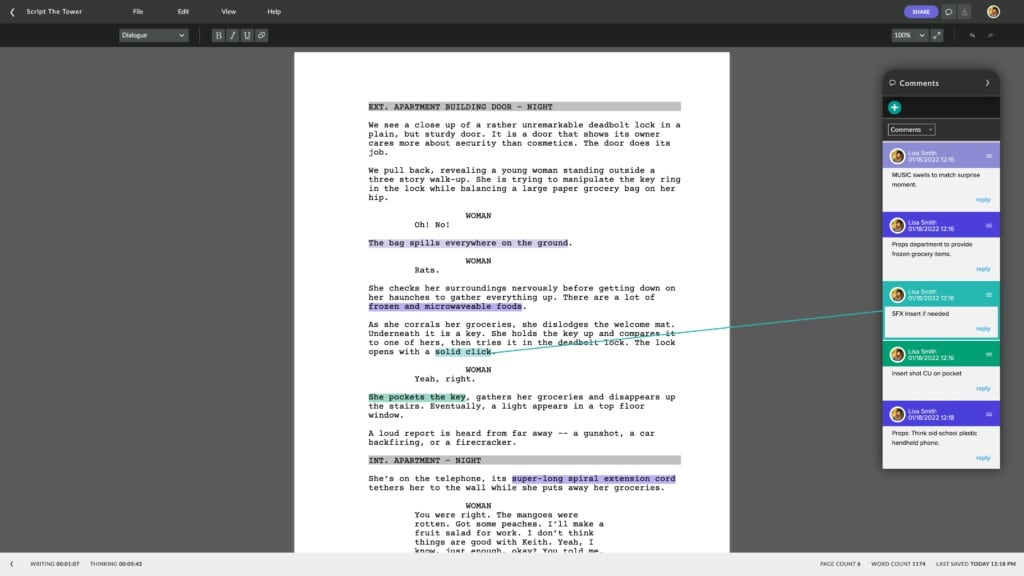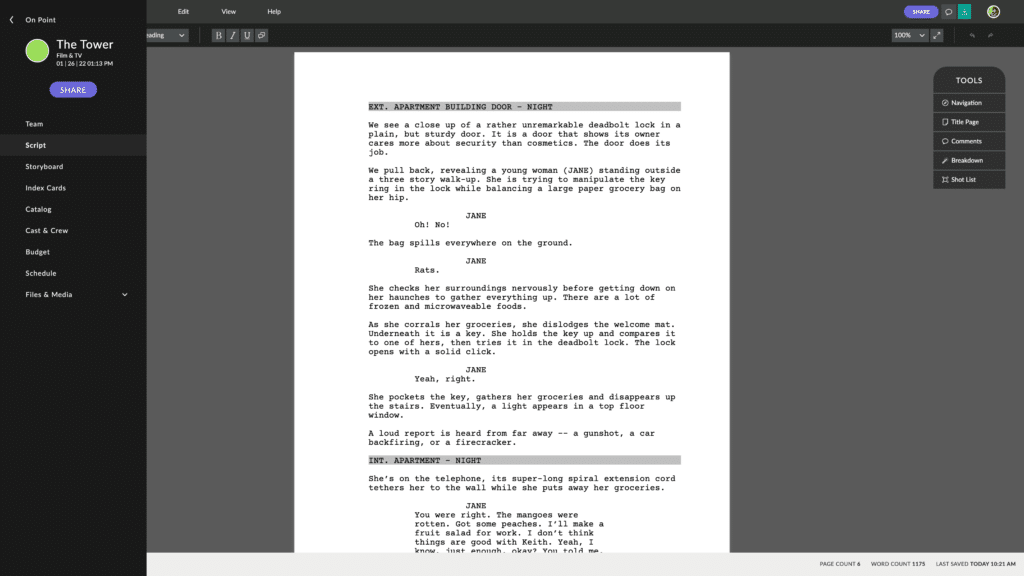

15.3K
What is a script? How long does it need to be, and most importantly, how to write a basic screenplay are some commonly asked questions amongst new, up and coming script and screenwriters.
Well, when we really break it down, a script is simply written work (all in size-12 courier font) of roughly 90 -120 pages which translates your creative word smithing into how the visuals and audio on screen will unfold.
On the surface, trying to write a script or screenplay is deceptively simple, partially because everybody intrinsically understands the language of cinematic storytelling.
It is an inevitable (and crucial) byproduct of growing up watching movies – everybody knows the feeling of being able to anticipate a character’s next move, or character dialogue, or scene locations or when the plot will shift directions, or when the monster is about to crash through the window. If you know movies, you know enough to write the screenplay, right?
Another part of the deception is the textual nature of script themselves: the formatting on the page creates a lot of empty space. Anyone who’s spent time in a script editor knows the giddy sensation of typing along and finding themselves suddenly ten, or twenty, or even thirty pages into a script.
The problem is that screenplays are as much technical documents as they are works of art. You could craft a beautifully heartfelt and original script that will be rendered completely unfilmable by virtue of the way that you wrote it.
You could have a one hundred and fifty page script that would only justify forty minutes of screen time. The margin for error in writing a script is enormous, because a screenplay isn’t a story to be read on its own: rather, it is a blueprint for creating something larger and much more complex.
Consider the Frankenstein metaphor: stitching the creature together is one thing, bringing it to life is something else entirely.
So how do you stitch together a good creature? Wait, I mean, so how does one write a good screenplay? For those new to the craft, here are some simple, helpful directives to get you on the right track.
A great way to start the process of writing a script is by coming up with a logline: one or two sentences that will encapsulate your story in an intriguing manner. Once you’re done with that, develop your characters. Write their backstories. Refine their personalities.
Think about what makes them tick. Always make sure that your characters have goals that they need to achieve, and ensure that those goals carry high stakes should your characters fail to meet them. This does not mean that their goals need to be lofty, they just need to be authentic. The stakes can be as high as the end of the world or as personal as the end of a friendship.
The point is that characters having purpose is what makes them interesting. Flat characters destroy scripts. No matter how great your action sequences are or how original your concept is, one dimensional and uninteresting characters will drag your story to a halt.
You’ll find that writing with your characters’ personalities and goals in mind will take your story in unexpected places, and usually for the better.
An outline (sometimes called a ‘beat sheet’) is a brief synopsis of your entire story. Try to fit it on one to two pages, and be concise. Broad strokes are key here. Think of the outline as the ‘definition’ of your script that breaks down the movement of the story, plot point by plot point. This is where you should begin to think about structure.
Essentially, conventional cinematic storytelling is bound to a classical format of three acts: It’s just how people expect stories to be told. There are many books written on the subject of screenplay structure, but the fundamentals are pretty simple. An average screenplay will be about ninety to one hundred pages.
Divide those pages by three. There’s your acts:
Now you get to start flexing your prose muscles and develop your style.
Treatments are effectively a more in-depth version of your outline. Expound upon it and write your whole story scene by scene in a conventional manuscript style. Experiment with dialog, or at least make note of what you want your characters to say. Develop your settings and have fun with descriptions.
The treatment is where you really start building the world that your story takes place in. The length of a treatment is dependant on both the kind of story you’re telling and the length of the intended finished product.
For reference, a typical feature treatment will clock in at around thirty pages.
Time to get to work.
Go to it, and godspeed. It’s always a good idea to write in a script editor like Celtx to help streamline the process. Celtx Studio features one that is tried, true, and hugely popular – and it’s free.
You’ve developed your characters, structured your plot, and have an inspired treatment. Understand the formatting. Write in the present tense. Brevity is your friend. Remember to show, not tell: you’re writing for the eyes and the ears.
Bonus Screenwritng Tip #1: If you’re feeling a little uninspired on the creative direction of your script, then a great trick is to take notes on the go of the interesting conversations, news articles, and people you encounter. This can be as simple as taking notes on your phone or a notepad.
Completing the first draft is an accomplishment to be celebrated, but it’s just the beginning. If you think your first draft is perfect, it’s not (sorry).
Go back, read it through, take stuff out, and add stuff in.
Get other people to read it and commit yourself to being open to constructive criticism. Don’t just look for feedback from professionals and editors – lovers of science fiction film, or plain old movie fans can offer advice just as sound as any seasoned screenwriter.
Throw your script out there and surround yourself with the ideas that come back. Always be refining and revising, and just when you think you can’t possibly revise any further, do it again.
It all comes down to practice. Most professional screenwriters complete multiple features before they write a script that sells. A select few hit it out of the park on the first draft. All will agree that you need to be dedicated, and that most of all, you need to love your story. If you don’t, it’ll never be complete.

Now that you have your framework lined up, it’s time to dive deeper into what it takes to write the final draft of a script. Below are 7 script writing tips that will help you when writing your first draft.
Write to your strengths. Like any new craft, scriptwriting will come with some fresh creative lessons.
Through the process of your first draft, you will learn how to build a script from an infant idea to a finished product, all while becoming familiar with the formatting and terminology along the way. Therefore, for your first draft, writing to your strengths is a great place to start.
What are you already good at? What do you already have a natural strength or interest in? Is there an area of work or the world that you know well? These questions are not designed to find any expert-level knowledge, they’re designed to probe what your strengths are.
You may be the comic of your group of friends, so try starting with a comedy. Perhaps you are the family historian, so a historic film or one with investigative themes may come more easily to your skillset.
Another way to approach writing to your strengths is to set the film in a place you are very familiar with, such as your hometown or country. Also, if you are not sure of your strengths, why not ask the people around you for some help?
Through conversations with others, you may realize areas of your life that you are passionate to discuss, whether it’s about your childhood, sport, social injustices, work, or family life.
Many of our most beloved films have their original scripts available online and are easily accessible for us to read and analyze. Try to find even two or three film scripts online for stories you are already familiar with and give them a read.
This is an enjoyable exercise, and chances are you will be amazed to read how such memorable scenes and movies were once first sketched out in words. You may even be surprised to see how stripped back the visual notes and script cues are that created these entire visual worlds on screen.
Your script should emulate this neat, efficient writing style when you are translating ideas for visuals into words.
Bonus Script Writing Tip #2: Writing a script can take as long as you want it to but, assuming this is a part-time project to be done while balancing other commitments, allocating 12 weeks of work should be enough time to complete a solid first draft.
Okay, so let’s say you want to write a movie script, then start by reflecting on why you love some movies and why you hate others. This is one of the best (and most fun) ways to learn how to write a movie script.
Take note of details you appreciated and try injecting similar elements into your own work. We can all easily sit back and enjoy our favorite films, but consciously analyzing the films we enjoy and taking notes of what elements work is helpful for getting our own scriptwriting and creative hats on.
If you’re not sure how to start picking apart your favorite films, take down notes for each of these categories: sound, dialogue, setting, character, editing, and lighting. These are some of the key script elements which create the mood and atmosphere on screen, so picking apart what you found effective will certainly inform your own script.
Also, while it is helpful to watch your favorite film (Happy Gilmore for me) to see how well all these things are executed, it can be just as helpful to watch, well . . . bad films too. Seriously! This may sound like an unusual piece of advice, but when you watch a bad movie, it can also quickly show you what elements are not working well.

Unlike great movies where all the elements flow and work together seamlessly, bad movies make their separate elements easy to spot and analyze. For example, The Room (2003) is a cult-hit “bad movie” which will help you see how key film elements, such as editing and dialogue, are disjointed.
If watching a great movie is eating an amazing meal at a restaurant, then watching a bad movie is more like stepping behind the scenes and into the chaotic kitchen.
Also, if you already have an idea for a film, do a little research into this genre. You may find more creative inspiration and wisdom in what the existing genre is doing and, perhaps, how your film could be a fresh take on an angle currently missing in the genre.
For example, if you want to write a horror film set inside a farmhouse, try watching some horror films and keep an extra eye out for horror films which are set predominantly inside.
While doing some research into films which thematically are similar to what you want to achieve will help you come away with a list of things you were inspired to do (and what not to do!), the possible sources of inspiration for your script are really endless. For another example, you could base your story from your own life, a book you read, a play you saw or a wild dream you just had.
Remember folks, at this stage, before getting into writing your script, you have complete creative license and agency, the creative origin point of this entire project. Of course, later down the line, scripts will be revised, partly rewritten, and tweaked to accommodate the needs of directors, producers, and the studio’s needs. But, right now, you’re in the creative driver’s seat!
You have an awesome idea, and you know what you want to do with your characters, but are you still wondering how your script will actually get written? This is a great place to be. Before cannonballing into the deep end, take these steps to thoughtfully build up your script like a screenwriting pro.
The first essential step is to write your script’s logline, also sometimes known as a “slugline.” This logline should be no longer than two sentences or about 50 words in length. Your logline should capture your script’s main obstacles or action into a single-sentence nutshell.
Of course your entire script cannot be boiled down into one line, but loglines are not designed to be comprehensive and fit your entire story in; they should describe the thrust of action facing your characters and hook the reader’s attention into reading the rest of your script.
The logline tends to focus on the central character’s mission and contextualizes them in the place they are starting. The logline for documentary Won’t You Be My Neighbour (2019), about the life of TV personality Mister Fred Rodgers reads, “A portrait of a man whom we all think we know, this emotional and moving film takes us beyond the zip-up cardigans and the land of make-believe, and into the heart of a creative genius who inspired generations of children with compassion and limitless imagination.”
You will notice an effective logline gives us a flavor of the story, a hint at the narrative but continues to leave readers seeking more information and depth. Your logline will be an excellent summary to keep on hand while writing your final script because it anchors your narrative and reminds you of your initial storytelling goals. Think of it as your storytelling mission statement.
The next key step in learning how to write a script is to make a beat sheet and treatment for your script. You can make your beat sheet and treatment documents in either order, depending on your own preference.
Your beat sheet is essentially a bullet-pointed skeletal version of your script. From beginning, middle to end, all the key moments are jotted down in chronological order. Each “beat” is a sentence or two long and simply states the action taking place.
For example, “Hannah arrives at work and realizes her car is missing”. Again, it is useful in this stage to avoid overly floral and descriptive language so that the action is really laid bare. It’s very common during this stage to identify gaps in your narrative, which is exactly why this exercise is so important.
Suddenly you may find yourself with some creative gap-filling and work to do, and that’s great. This is the ideal time for you to spot untethered parts of your story and fix them into place. There are two common and constructive methods for crafting a beat sheet: using a Word document to bullet point these action beats or using index cards with a sentence on each and ordering and reordering them as needed.
If running through your script in chronological order is proving too difficult for now, try starting at the end or the middle and working backwards. Most scripts are structured in a tripartite way, meaning you will have one third dedicated to the beginning, a middle third with a focus on the action, and the last third for the dramatic final act.
This storytelling structure follows a “set-up, confrontation, and resolution” approach. Splitting-up your bullet points over three pages, with approximately 30 points on each, will be roughly enough beats for a 90-minute movie. Whether you have a bullet pointed list or ordered index cards on a board, your finalized beat sheet should make it clear how your script’s action unfolds from beginning to end.
Bonus Script Writing Tip #3: A useful measure of your script’s length is the same way most writers and producers calculate your script length – one page of your script equating to one minute of the film on screen. Simple, right?
Next, with your logline and beat sheet completed, it is time to write your script’s treatment. This is a 3 to 5 page document which uses descriptive language and brings your lean beat sheet into a short story format which more vividly brings your story and characters to life.
This is the perfect opportunity to highlight your character profiles in detail by describing their characteristics and motivations. A script treatment is often used as a kind of marketing tool which would accompany your script when being sent to potential buyers or producers, therefore it is important to have a strong treatment which actively portrays the themes, visuals, and overall tone of your script.
Writing your treatment is like writing a descriptive and polished blurb for your film.
Now, it is time to open your scriptwriting software, jump to the first page, set yourself a realistic deadline for completing this script and get writing. Start by writing your script’s title page – this includes the film’s title, your name and contact email on the title page, and then get into the script!

It’s essential to familiarize yourself with scriptwriting language before writing your script.
Most scripts are considered to be a “spec script”, as a short way of saying “speculative script.” Later in the creative process your script would need to be iterated by directors and producers into a “shooting script” to get the script camera ready.
A shooting script contains more detail for editing purposes and camera angles for the purposes of filming, which directors will infuse based on their own visions. Remember, while you are writing your ‘spec script’, you do not need to include details on camera angles or how scenes will transition at this stage. Stick to the story.
Don’t worry, you won’t have to learn a whole new scriptwriting language to write. However, there are a handful of terms which you should learn because you’ll employ them constantly while writing. By writing your screenplay with a baseline familiarity or, better yet, a firm grasp of these terms, then your work will just continue to flow more easily.
These terms are the fundamental building blocks of scriptwriting language and will come up in every script you read or write!
With all these scriptwriting phrases and abbreviations under your belt, you’ll find it easier to write and make sense of the scriptwriting software you decide to use. Almost all scriptwriting software today intuitively formats your script out for you – meaning it will add details like parentheticals and formatting conventions like capitalized scene headings wherever appropriate, which makes your life easier and script better.
There are a bevy of professional, quality, and affordable scriptwriting softwares available online. Not only will investing in scriptwriting software make it easier to format your work, but it will also teach you a great deal about the correct, standardized script format used throughout the entire entertainment industry.
Scripts have a rigid and strictly adhered-to format, and the sooner you become fluent in this scriptwriting language, the better.
Having a reliable and intuitive screenwriting software used to assist you through the screenwriting process will make your life much easier, and instead of being bogged down with formatting, you can focus your energy and attention into the storytelling.

Like any new challenge or project, there will be ebbs and flows of inspiration and willingness to see your screenplay through to the end.
It’s useful to anticipate difficult moments where you feel at a loss as to how to continue and finish this massive endeavor. That’s ok! And what every writer on the planet experiences regularly.
Don’t worry about finding a blockbuster-worthy moment straight away; often the best insights and creativity are found in day-to-day encounters. Keep an eye out, take note, and switch on your creative antenna in the process.
If you prepare for moments of “writers’ block”, then you’re better preparing yourself for successfully overcoming that hurdle.
Also, if you hit a writers’ block then you’re in good company as countless notable scriptwriters experience this too. Recently Taika Waititi reassured an audience that opening your laptop, staring at a blank document, feeling sad, and then closing your laptop is “still classified as writing”.
Writing an amazing script will require constant dedication – be patient with yourself and stick at it!

Andrew Stamm is based in London with his wife and dog. He spends his working time as Partner and Creative Director at Estes Media, a budding digital marketing agency, and performs freelance scriptwriting services on the side. Off the clock he loves to bake, hike, and watch as many niche films as possible. View all posts